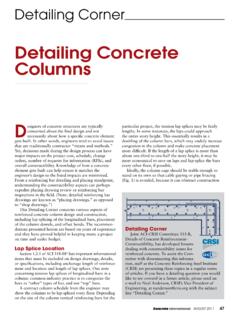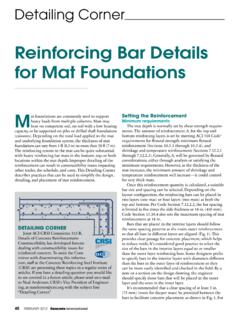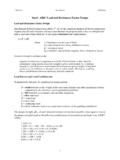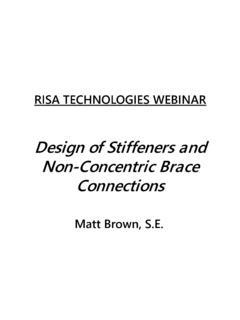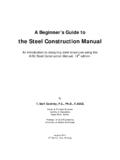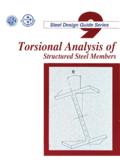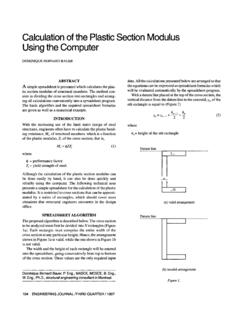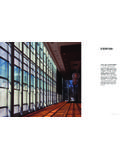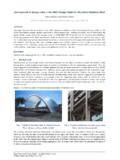Transcription of Base Plate and Anchor Rod Design - Portada
1 1. Steel Design Guide base Plate and Anchor Rod Design Second Edition base Plate and 1. Steel Design Guide Anchor Rod Design Second Edition JAMES M. FISHER, , Computerized Structural Design , Milwaukee, Wisconsin and LAWRENCE A. KLOIBER, LeJuene Steel Company Minneapolis, Minnesota AMERICAN INSTITUTE O F S T E E L C O N S T RU C T I O N , I N C. Copyright 2006. by American Institute of Steel Construction, Inc. All rights reserved. This book or any part thereof must not be reproduced in any form without the written permission of the publisher. The information presented in this publication has been prepared in accordance with recognized engineering principles and is for general information only. While it is believed to be accurate, this information should not be used or relied upon for any specific application without compe- tent professional examination and verification of its accuracy, suitability, and applicability by a licensed professional engineer, designer, or architect.
2 The publication of the material contained herein is not intended as a representation or warranty on the part of the American Institute of Steel Construction or of any other person named herein, that this information is suitable for any general or particular use or of freedom from infringement of any patent or patents. Anyone making use of this information assumes all liability arising from such use. Caution must be exercised when relying upon other specifications and codes developed by other bodies and incorporated by reference herein since such material may be modified or amended from time to time subsequent to the printing of this edition. The Institute bears no responsi- bility for such material other than to refer to it and incorporate it by reference at the time of the initial publication of this edition.
3 Printed in the United States of America First Printing: May 2006. Acknowledgements The authors would like to thank Robert J. Dexter from AISC would also like to thank the following individuals the University of Minnesota, and Daeyong Lee from the who assisted in reviewing the drafts of this Design Guide for Steel Structure Research Laboratory, Research Institute of their insightful comments and suggestions. Industrial Science & Technology (RIST), Kyeonggi-Do, Victoria Arbitrio Donald Johnson South Korea, for their writing of Appendix A and the first Reidar Bjorhovde Geoffrey L. Kulak draft of this Guide. The authors also recognize the contribu- Crystal Blanton Bill R. Lindley II. tions of the authors of the first edition of this guide, John Charles J.
4 Carter David McKenzie DeWolf from the University of Connecticut and David Brad Davis Richard Orr Ricker (retired) from Berlin Steel Construction Company, Robert O. Disque Davis G. Parsons II. and thank Christopher Hewitt and Kurt Gustafson of AISC. James Doyle William T. Segui for their careful reading, suggestions, and their writing of Richard M. Drake David F. Sharp Appendix B. Special appreciation is also extended to Carol Samuel S. Eskildsen Victor Shneur T. Williams of Computerized Structural Design for typing Daniel M. Falconer Bozidar Stojadinovic the manuscript. Marshall T. Ferrell Raymond Tide Roger D. Hamilton Gary C. Violette John Harris Floyd J. Vissat Allen J. Harrold v vi Table of Contents INTRODUCTION.
5 1 base Plate Flexural Yielding at Tension 25. MATERIAL, FABRICATION, General Design Procedure .. 25. INSTALLATION, AND REPAIRS .. 2. Design of Column base Plates with Large Moments .. 25. Material Specifications .. 2. Concrete Bearing and base Plate Material 2. Anchor Rod Forces .. 25. base Plate Fabrication and Finishing .. 3. base Plate Yielding Limit base Plate Welding .. 4 at Bearing Interface .. 26. Anchor Rod Material .. 5 base Plate Yielding Limit Anchor Rod Holes and 6 at Tension 27. Anchor Rod Sizing and Layout .. 7 General Design Procedure .. 27. Anchor Rod Placement and Tolerances .. 7 Design for Shear .. 27. Column Erection Procedures .. 8 Friction .. 27. Setting Nut and Washer 8 Bearing.
6 27. Setting Plate Method .. 9 Shear in Anchor Rods .. 29. Shim Stack Method .. 9 Interaction of Tension and Setting Large base Plates .. 9 Shear in the Concrete .. 30. Grouting Requirements .. 9 Hairpins and Tie Rods .. 30. Anchor Rod Repairs .. 10 Design EXAMPLES ..31. Anchor Rods in the Wrong Position .. 10. Anchor Rods Bent or Not Vertical .. 10 Example: base Plate for Concentric Axial Compressive Load Anchor Rod Projection Too Long (No concrete confinement) .. 31. or Too Short .. 10. Example: base Plate for Concentrix Axial Anchor Rod Pattern Rotated 90 .. 12. Compressive Load Details for Seismic Design D .. 12 (Using concrete confinement) .. 32. Example: Available Tensile Strength of a Design OF COLUMN base .
7 W-in. Anchor Rod .. 34. Plate CONNECTIONS ..13. Example: Concerete Embedment Strength .. 34. Concentric Compressive Axial Loads .. 14 Example: Column Anchorage for Concrete Bearing Limit .. 14 Tensile Loads .. 34. base Plate Yielding Limit Example: Small Moment base Plate Design .. 37. (W-Shapes) .. 15 Example: Large Moment base Plate Design .. 38. base Plate Yielding Limit Example: Shear Transfer Using Bearing .. 40. (HSS and Pipe) .. 16 Example: Shear Lug 40. General Design Procedure .. 16 Example: Edge Disttance for Shear .. 42. Tensile Axial Loads .. 18 Example: Anchor Rod Resisting Combined Anchore Rod Tension .. 19 Tension and Shear .. 42. Concrete Anchorage for Tensile Forces .. 19. Design of Column base Plates with APPENDIX A.
8 47. Small 23. Concrete Bearing Stress .. 24 APPENDIX B .. 55. base Plate Flexural Yielding Limit at Bearing Interface .. 24. vii viii INTRODUCTION. Column base Plate connections are the critical interface the equations shown herein are independent of the load ap- between the steel structure and the foundation. These con- proach and thus are applicable to either Design methodology. nections are used in buildings to support gravity loads and These are shown in singular format. Other derived equations function as part of lateral-load-resisting systems. In addition, are based on the particular load approach and are presented they are used for mounting of equipment and in outdoor sup- in a side-by-side format of comparable equations for LRFD.
9 Port structures, where they may be affected by vibration and or ASD application. fatigue due to wind loads. The typical components of a column base are shown in base plates and Anchor rods are often the last structural Figure steel items to be designed but are the rst items required Material selection and Design details of base plates can on the jobsite. The schedule demands along with the prob- signi cantly affect the cost of fabrication and erection of lems that can occur at the interface of structural steel and steel structures, as well as the performance under load. reinforced concrete make it essential that the Design details Relevant aspects of each of these subjects are discussed take into account not only structural requirements, but also brie y in the next section.
10 Not only is it important to Design include consideration of constructability issues, especially the column- base - Plate connection for strength requirements, Anchor rod setting procedures and tolerances. The impor- it is also important to recognize that these connections tance of the accurate placement of Anchor rods cannot be affect the behavior of the structure. Assumptions are over-emphasized. This is the one of the key components to made in structural analysis about the boundary conditions safely erecting and accurately plumbing the building. represented by the connections. Models comprising beam or The material in this Guide is intended to provide guidelines truss elements typically idealize the column base connection for engineers and fabricators to Design , detail, and specify as either a pinned or xed boundary condition.

